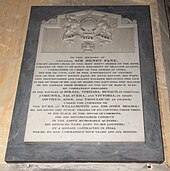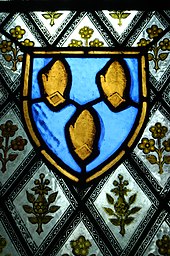Henry Fane (British Army officer)
Sir Henry Fane | |
|---|---|
Army Gold Cross with 4 clasps | |
| Other work | Member of Parliament |



Origins
He was the eldest son of Hon. Henry Fane (d.1802), of Fulbeck Hall, Lincolnshire, younger son of Thomas Fane, 8th Earl of Westmorland.
Military career
Fane joined the
Peninsular War
As a brigadier general, Fane commanded a brigade in Wellesley's army at the Battle of Vimeiro in August 1808. His brigade, which included the 1/50th West Kents, 5/60th Royal Americans, and four companies of the 2/95th Rifles, took a key part in repelling the French frontal attacks on Vimeiro village.[2]
During Sir John Moore's expedition in Spain, Fane commanded the 2nd Brigade (1/38th 1st Staffordshire, 1/79th Cameron Highlanders, 1/82nd Prince of Wales Volunteers Foot) in Alexander Mackenzie Fraser's 3rd Division. The 3rd Division was present but not engaged at the Battle of Corunna in January 1809.[3]
Fane missed the Second Battle of Porto, since his heavy cavalry brigade (3rd Prince of Wales Dragoon Guards, 4th Queen's Own Dragoons) was guarding the Portuguese frontier at Abrantes. While commanding the same brigade, he fought at the Battle of Talavera in July 1809.[4]
On 13 May 1810, Fane transferred to command a brigade that included the 13th Light Dragoons and four Portuguese mounted regiments. He was present at the Battle of Bussaco, while attached to Rowland Hill's 2nd Division. He went home ill before the end of 1810.[5]
On 24 April 1813, Fane was promoted to major general on the staff. Posted to command a brigade consisting of the 3rd Dragoon Guards and the 1st Royal Dragoons on 20 May,[6] he fought at the Battle of Vitoria in June. In that battle, his cavalry fought with Hill's Right Column, being lightly engaged.[7]
During late 1813, Wellington sent most of his cavalry to the rear since they were almost useless in the rough terrain of the Pyrenees. In January 1814, Fane transferred to lead a brigade that included the 13th and 14th Light Dragoons. There is evidence that Fane effectively commanded both his old and new brigades in the final battles in southern France.[8] Wellington called his cavalry forward in February, his light cavalry arriving first.[9] Fane's brigade fought at the Battle of Orthez and was present at the Battle of Toulouse in April.[10]
For his Peninsula service, Fane was awarded the
Later career
He was made a KCB in 1815 and a GCB in 1826. Fane sat as MP for Lyme Regis in 1802–1816, MP for Sandwich in 1829–1830 and MP for Hastings in 1830–1831. He was named Commander-in-Chief of India in 1835.
He died on 24 March 1840, aged 61.[11] His tomb in Fulbeck was designed by Edward Hodges Baily.[12]
Mistress and illegitimate issue
Fane formed a "strong attachment" to Isabella Gorges, a daughter of
- Col. Henry Fane (1802–1836), life tenant of
- Isabella Fane (1804–1880), spinster.[18] Her letters from India, while acting as her father's hostess between 1835 and 1838, are described as "corrective to the notion that all Englishwomen in India were of the straight-laced memsahib type – snobbish, imperious and racially prejudiced".[19] She returned to England but she could not get on with her family and went to live and die in France.[20]
- Rev. Arthur Fane (1809–1872), vicar of Gerard Nevile Mark Fane, who assumed the additional surname of Trefusis following the death of his grandmother Harriet, and became 22nd Baron Clintonin 1965, having claimed the termination of the 1957 abeyance of that title.
References
- Glover, Michael. The Peninsular War 1807–1814. London: Penguin, 2001. ISBN 0-14-139041-7
- Oman, Charles. Wellington's Army, 1809–1814. London: Greenhill, (1913) 1993. ISBN 0-947898-41-7
- Philippart, John (1820). The Royal Military Calendar or Army Service and Commission Book. Vol. III.
- Smith, Digby. The Napoleonic Wars Data Book. London: Greenhill, 1993. ISBN 1-85367-276-9
- Zimmermann, Dick. "Battle of Vimeiro," Wargamer's Digest magazine, vol 10, no 12, October 1983.
Footnotes
- ^ Philippart 1820, p. 25.
- ^ Zimmermann, p 33
- ^ Smith, p 278
- ^ Glover, p 373-4
- ^ Oman, p 346
- ^ Oman, p 367
- ^ Smith, p 430
- ^ Oman, p 372
- ^ Glover, p 313
- ^ Smith, p 518
- ^ Urban, Sylvanus: The Gentleman's Magazine, vol 4, p 426. William Pickering
- ^ Dictionary of British Sculptors 1660–1851 by Rupert Gunnis
- ^ Fisher, David R. "FANE, Sir Henry (1778-1840), of Fulbeck, nr. Grantham, Lincs. and Avon Tyrell, Hants". History of Parliament Online. Retrieved 10 February 2022.
- ^ Source: his will, copy held by Lincolnshire Archives, 1 FANE 4/8. He is stated erroneously in some otherwise reputable biographies to have died without progeny
- ^ Debrett's Peerage, 2015, p. 258, Baron Clinton (Fane-Trefusis)
- ^ Per his will, Lincolnshire Archives, 1 FANE 5/37/2
- ^ a b Per will of sister Isabella Fane (d.1880)
- ^ Per her will, Lincolnshire Archives, 1 FANE 5/26/1
- ^ Miss Fane in India, edited by John Pemble, Allan Sutton Publishing Ltd 1985, p. 4.
- ISBN 978-0-19-861412-8, retrieved 17 August 2023
- ^ Howell, Danny. "Church And Churchyard Memorials At St. Denys, Warminster, Recorded in 1882". Retrieved 29 October 2020.
- ^ "Warminster: Church". A History of the County of Wiltshire, Volume 8. Victoria County History. University of London. 1965. pp. 117–124. Retrieved 10 February 2022 – via British History Online.
- ^ Alumni Oxonienses: the Members of the University of Oxford, 1715–1886. Oxford: Parker and Co – via Wikisource. p. 445
External links
- Hansard 1803–2005: contributions in Parliament by Henry Fane


